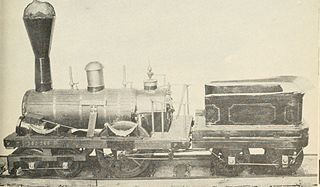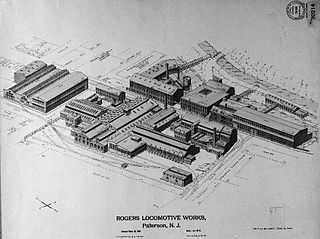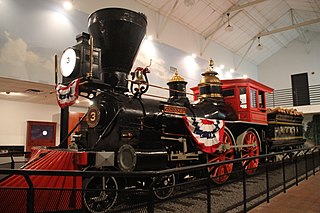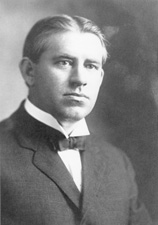Related Research Articles

William Paterson was a New Jersey statesman and a signer of the United States Constitution. He was an Associate Justice of the United States Supreme Court and the second governor of New Jersey.

The Great Falls of the Passaic River is a prominent waterfall, 77 feet (23 m) high, on the Passaic River in the city of Paterson in Passaic County, New Jersey, United States. The falls and surrounding area are protected as part of the Paterson Great Falls National Historical Park, administered by the National Park Service. The Congress authorized its establishment in 2009.
Robert Hughes may refer to:

Sandusky was the name of a steam railroad locomotive, a 4-2-0, built in the United States. This locomotive included engineering features that hadn't been used before in locomotive construction and it played an integral role in the railroad history of Ohio.

4-4-0 is a locomotive type with a classification that uses the Whyte notation for the classification of steam locomotives by wheel arrangement and represents the arrangement: four leading wheels on two axles, four powered and coupled driving wheels on two axles, and a lack of trailing wheels. Due to the large number of the type that were produced and used in the United States, the 4-4-0 is most commonly known as the American type, but the type subsequently also became popular in the United Kingdom, where large numbers were produced.
John Cooke (1824–1882) was one of the principals of Cooke Locomotive Works, one of the constituent companies that made up American Locomotive Company in the merger of 1901.

Rogers Locomotive and Machine Works was a 19th-century manufacturer of railroad steam locomotives based in Paterson, in Passaic County, New Jersey, in the United States. It built more than six thousand steam locomotives for railroads around the world. Most railroads in 19th-century United States rostered at least one Rogers-built locomotive. The company's most famous product was a locomotive named The General, built in December 1855, which was one of the principals of the Great Locomotive Chase of the American Civil War.

Western & Atlantic Railroad #3 General is a 4-4-0 "American" type steam locomotive built in 1855 by the Rogers, Ketchum & Grosvenor in Paterson, New Jersey for the Western & Atlantic Railroad, best known as the engine stolen by Union spies in the Great Locomotive Chase, an attempt to cripple the Confederate rail network during the American Civil War. Today, the locomotive is preserved at the Southern Museum of Civil War and Locomotive History in Kennesaw, Georgia, and is listed on the National Register of Historic Places.
Jacob S. Rogers was an American businessman.
William Swinburne (1805–1883) was a pioneering builder of steam locomotives in the United States.

William Hughes was an American politician of Irish origin. A member of the Democratic Party, he served in both houses of the United States Congress as the U.S. Representative for New Jersey's 6th congressional district from 1903 to 1905 and again from 1907 to 1912 and a United States senator from New Jersey from 1913 to 1918.

Philip Allen was an American manufacturer and politician from Rhode Island. He served as Governor of Rhode Island and as a Democratic member of the United States Senate.
The Paterson and Hudson River Railroad was a railroad that operated in New Jersey and connected the cities of Jersey City and Paterson. The railroad was started in 1833.

Louisville & Nashville No. 152 is a 4-6-2 Pacific Class locomotive listed on the National Register of Historic Places, currently at the Kentucky Railway Museum at New Haven, Kentucky, in southernmost Nelson County, Kentucky. It is the oldest known remaining 4-6-2 Pacific to exist. It is also the "Official State Locomotive of Kentucky", designated as such on March 6, 2000.

Paterson Museum is a museum in Paterson, in Passaic County, New Jersey, in the United States. Founded in 1925, it is owned and run by the city of Paterson and its mission is to preserve and display the industrial history of Paterson. It is located in the Old Great Falls Historic District.

Grant Locomotive Works was a manufacturer of steam railway locomotives from 1867 to 1895, first in Paterson, New Jersey, and then in Chicago. The company built about 1,888 locomotives.
Isaac Dripps was an American machinist and inventor. He worked on the locomotive John Bull and built seven locomotives. Dripps was a superintendent and partner of various railroad machinery shops. He has several patents to his name.

Paul Rapsey Hodge was an English-American inventor and mechanical engineer. He also worked as a writer of technical manuals in both the United States and England.

Abraham Godwin Jr. was the first Lieutenant of the expedition to Canada in 1812 led by Generals Brown and Izard. He later rose to the rank of Brigadier General in the New Jersey state militia. In 1816 when his eldest brother Henry committed suicide, he became Postmaster of Paterson, a position he would hold until 1829, and briefly again before his death in 1849. In 1821, he was elected to the New Jersey General Assembly, of which he served until 1832. In November 1840, Abraham was tasked to take the New Jersey votes to Washington, D.C. for the Presidential Election.
References
- ↑ Moshein, Peter & Rothfus, Robert R. (1992). "Rogers locomotives: A brief history and construction list". Railroad History. 167: 13–147.
- ↑ Boyd, William, compiler. "Directory of the City of Paterson 1859" . Retrieved October 14, 2005.CS1 maint: multiple names: authors list (link)
| This biography related to rail transport in the United States is a stub. You can help Wikipedia by expanding it. |